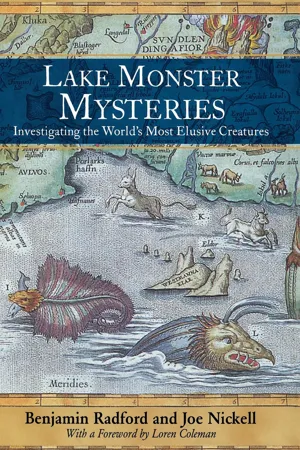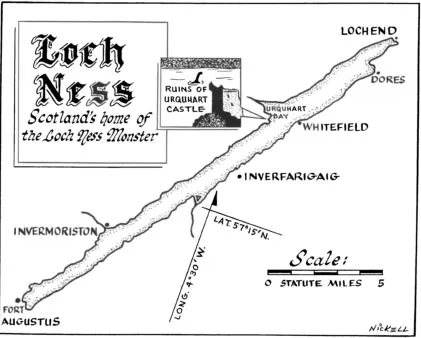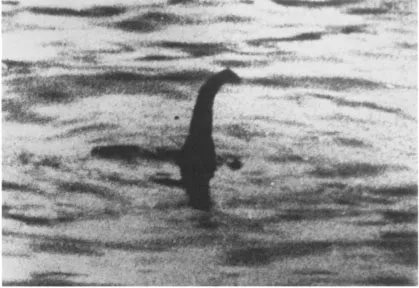![]()
1
LOCH NESS
Of all the sea serpent-like creatures that are reputed to inhabit some of the world’s large lakes, none is more famous than “Nessie,” the purported Loch Ness monster (figure 1.1). Supported by sightings, photographs, and other evidence, Nessie continues to spark the popular imagination.
SIGHTINGS
Reports of the existence of a creature in the great Scottish lake date as far back as the sixth century, when St. Columba supposedly saved a man’s life by commanding the attacking monster to depart. (Such pious legends of saints—some of whom could reportedly fly and others who could allegedly live without eating—are given little credence today [Nickell 1993, 231–63].) The number of subsequent encounters is disputed until the twentieth century, when the modern wave of sightings began.
On May 2, 1933, the Inverness Courier carried an account by an anonymous correspondent (actually, one Alexander Campbell) titled “Strange Spectacle in Loch Ness,” telling how an unnamed couple had seen the waters of the loch disturbed by “no ordinary denizen of the depths,” at least “judging by the state of the water in the affected area.” It later turned out that Campbell’s account was greatly exaggerated: only one of the two individuals had seen anything, and that person had described it as seeming to be caused “by two ducks fighting” (Binns 1984, 12).
The week after Campbell’s report, the Courier published a response by Captain John Macdonald, who responded: “In the first place, it is news to me to learn, as your correspondent states, that ‘or generations the Loch has been credited with being the home of a fearsome monster.’ I have sailed on the Loch Ness for fifty years, and during that time I have made no fewer than 20,000 trips up and down Loch Ness. During that half-century of almost daily intercourse with Loch Ness I have never seen such a ‘monster’ as described by your correspondent.” Captain Macdonald had seen “what at first might be described as a ‘tremendous upheaval in the Loch,’” but he ascribed this “very ordinary occurrence” to “sporting salmon” (quoted in Binns 1984, 16).
Figure 1.1 Scotland’s Loch Ness is home to the world’s most famous legendary lake creature. (Map by Joe Nickell)
Nevertheless, more sightings soon followed, with the monster being variously described as 6 to 125 feet long, with shapes ranging from that of a great eel to a creature with a hump or humps (up to nine), and in colors including silver, gray, blue-black, black, and brown (figure 1.2). It was also endowed—or not—with such features as fins, flippers, mane, tusks, or horns (Binns 1984; Gould 1934).
Figure 1.2 Composite drawing from the wildly diverse descriptions of the Loch Ness monster (a.k.a. “Nessie”), or herewith dubbed Nessiteras chameleonopteryx. (Illustration by Joe Nickell)
In his definitive, skeptical book on the subject, The Loch Ness Mystery Solved, Ronald Binns (1984) cataloged many of the live creatures and inanimate objects that have been mistaken for Nessie, including bobbing logs, boat wakes, schools of fish, long-necked birds, swimming deer, and many other animals, notably the European otter (Lutra lutra). With its long neck and plesiosaurlike profile, the otter is quite likely to be perceived as a monster, especially when an adult with two or more young are swimming in a line, creating the semblance of a multihumped creature.
In August 1933, eight weeks after the sighting reported by Campbell, a Mr. Spicer saw a creature like “a pre-historic animal” cross the road about fifty yards in front of his automobile. It was carrying a small animal in its jaws, and its long neck undulated as it walked. Spicer estimated it as six to eight feet long and speculated that it might be both a “land and water animal.” Indeed, as one of Spicer’s contemporaries told the Inverness Courier, the creature was almost certainly a large otter, possibly carrying one of its young (Binns 1984, 19–20).
Monster enthusiast Rupert T. Gould, author of The Loch Ness Monster (1934), loved to cite the most unlikely theories about Nessie. The more ridiculous these were, the more he seemed to like discussing them (making, as it were, a straw-monster argument). On Gould’s list were mass hallucination, a hollow log “inhabited by a colony of aquatic creatures,” “the reflection on the water of some object on one of the surrounding hills,” the action of an underwater geyser, various saltwater creatures (e.g., shark, sunfish, ray, or squid) that somehow found their way into the loch (but could not survive there), and many other imaginative possibilities—including a dead elephant. One of Gould’s methods of dismissing even likely explanations for some of the sightings was by invoking other sightings that could not be so explained—as if there could be only a single explanation for Nessie (e.g., Gould 1934, 117).
In 2001, Italian geologist Luigi Piccardi suggested that the loch leviathan could be an illusion created by seismic activity, since the Great Glen Fault runs along Loch Ness. Nessie hunter Adrian Shine responded that Piccardi’s hypothesis could account for only some of the monster reports, and he insisted that boat wakes were the most persistent explanation for lake monster sightings. He also noted that water on the surface could actually flow against the wind, creating the illusion that an inanimate object, such as a log, was an animate one swimming into the wind (Barr 2001).
HOAXES
Not surprisingly, hoaxers as well as tourists have been attracted to the purported monster. One hoax involved the appearance of monster tracks curiously resembling those of a hippopotamus. Indeed, they had been produced using a cast made from a hippo’s hoof, apparently taken from an umbrella stand (Nickell 1995, 241–43).
Hoaxing was also the apparent explanation for the July 2003 discovery on the loch’s shore of a fossil vertebra that was believed to be that of a plesiosaur (an extinct marine reptile). Although the fossil was authentic, it was embedded in a limestone that was not native to the area. National Museum of Scotland paleontologist Lyall Anderson speculated that the fossil had been planted at the loch to suggest that it came from a Nessie skeleton. The total absence of skeletal evidence is a recurring argument against lake monsters’ existence (Radford 2003).
The tradition of such Loch Ness hoaxes continues to the present day. In 2005, several new Nessie hoaxes surfaced. The most interesting was a reputed monster tooth that was found embedded in a deer carcass along the lakeshore by two American college students. The tooth was reportedly confiscated by a Scottish game official, creating whispers of a conspiracy. The “monster tooth” was later revealed to be part of a deer antler, and the whole thing was just a publicity stunt for a new novel about the loch (Boese 2005).
Fake photos of the monster abound as well, possibly including the first one, presented in 1933—just six months after the Campbell-reported sighting. It was taken by Hugh Gray, a man described as a “leg-puller,” and it depicts “a blurred and indistinct serpentine shape” (Binns 1984, 98, 209). One pro-Nessie writer, Tim Dinsdale, conceded: “It does not show very much of anything. The print has either been touched up, or light has spoiled the picture. There are other features in it which are peculiar” (quoted in Binns 1984, 99). But what about the most celebrated photograph of the Loch Ness monster?
THE FAMOUS PHOTOGRAPH
In April 1934, the quintessential photo of Nessie was allegedly snapped by London gynecologist Robert Wilson (figure 1.3). Known as the “surgeon’s photograph,” it is the most famous depiction of the creature, showing it with a long neck and small head, somewhat resembling a plesiosaur, silhouetted against the sunlit water. A second photo by Wilson was of relatively poor quality.
Over the years, Wilson seemed to tire of the controversy he had stirred up, telling one journalist that he had never claimed to have photographed a monster and that, moreover, he didn’t believe in the creature. Subsequently, Wilson’s youngest son “bluntly admitted that his father’s pictures were fraudulent” (Binns 1984).
Then in 1994, two Loch Ness researchers made news when they provided information that the photos were indeed a hoax, that they depicted a model made from a toy submarine to which a neck and head fashioned of wood putty had been affixed (Nickell 1995). The researchers’ source was the late Christian Spurling, who, two years prior to his death in late 1993, told how the prank had been conceived by his stepfather, Marmaduke Wetherell, with Dr. Wilson agreeing to take the photos (Genoni 1994).
Figure 1.3 The famous “surgeon’s photo” of Nessie, taken by London gynecologist Robert Wilson in April 1934, has been revealed as a hoax. (Photo by Robert K. Wilson)
Subsequently, Richard D. Smith (1995), writing in Fate (a magazine that promotes belief in the paranormal), claimed that the hoax itself was a hoax, that Spurling’s story did not ring true. Smith insisted that the uncropped photograph shows that it was not taken in “an inlet where the tiny ripples would look like full-sized waves,” as alleged, and he raised other objections. For example, he noted that an estimate of the scale based on the presumed size of the ripples argues that the creature was larger than the model Spurling described. He also cited the implausibility of the explanation of why the model no longer exists: “Supposedly because the water bailiff [Alex Campbell] appeared and Wetherell quickly stepped on the toy, sinking it.” Smith’s credibility was not helped by the placement of his article—sandwiched between a testimonial, “My Glimpse of Bigfoot,” and an article suggesting that “alien technology” was responsible for the strange hybrid creatures of Greek mythology.
It seemed to me that Smith’s points ranged from the weak to the dubious, but I decided to solicit a more expert opinion. I therefore wrote to Ronald Binns in 1995, and he responded with a detailed three-page letter. He began by conceding that Smith’s perceived faults with Spurling’s story might suggest that the hoax was bogus. However, he noted:
On the other hand, as Spurling was an old man when he was interviewed maybe he was just confused. After more than half a century anyone’s memory would surely be unreliable. Maybe he was right about how the model was made but wrong about the dimensions. Maybe the model sank accidentally (as did the hugely expensive model monster made for the Billy Wilder film The Private Life of Sherlock Holmes).
Even if the object was 1.2 metres high, so what? It could still have been a model. My own fake Nessie (Plate 3 of The Loch Ness Mystery Solved) was a tiny cardboard cut-out head and neck stuck in the neck of a mineral-water bottle and covered in black plastic from a garbage bag (about 12” out of the water). It took ten minutes to make. I don’t doubt the Wilson model was better constructed. In the Wilson photo the dark shapes to the left and right of the head and neck could very well be the top portion of a toy submarine.
The second Wilson photograph obviously portrays a different object photographed in different weather conditions (and I suspect from a different angle). It may have been a cruder model, or it may have been a bird. If it is “rarely seen,” as Smith claims, that is because it is a bad photo of a very dubious object. Since it obviously isn’t the object shown in the more famous photo, the obvious question is how did Wilson manage to photograph two monsters?
Binns (1995) continued:
Black and white photographs are so much easier to fake than colour photographs, and still photographs are so much easier to fake than home-movie or video film. The fact that the object shown in Wilson’s photograph is very close to the shore is itself very suspicious, as this is just what one would expect from a model thrown into the loch. There is also almost what amounts to a basic rule about Nessie photos and films. The photos, being fakes and/or models, are always of an object relatively close to the photographer. The movie film, being genuine footage of an object which is not a monster, is always too far away to be properly identifiable.
Richard D. Smith is wrong about the object not being photographed in an inlet. The part of the loch where Wilson said he took his photo consists of a series of inlets and there is no reason to suppose it wasn’t photographed in one of these inlets (the promontories of which would not have shown in the Wilson photo). Now that we have most of the original print what is surely striking is how the object photographed is more or less dead centre—rather too neatly and well composed for what is alleged to be an animal photographed by chance.
Lastly, there is the curious anomaly of the date. Wilson told the Daily Mail he took the photograph on April 19th (1934). However, in Rupert Gould’s book The Loch Ness Monster (1934) the date is given as April 1st. Perhaps this was a misprint, or perhaps the information came from Wilson and was his way of signalling that the photo was a leg-pull (since in Britain April 1st is “All Fool’s Day” when leg-pulling and practical jokes are the order of the day and even the newspaper...



